Port Erin
| Port Erin | |
| Manx: Purt Çhiarn | |
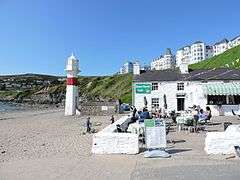 The Cosy Nook cafe on the western end of Port Erin beach. |
|
 Port Erin |
|
| Population | 3,530 (2011 census) |
|---|---|
| – Douglas | 12 miles (19 km) |
| Parish | Rushen |
| Sheading | Rushen |
| Crown dependency | Isle of Man |
| Post town | Isle Of Man |
| Postcode district | IM9 |
| Dialling code | 01624 |
| Police | Isle of Man |
| Fire | Isle of Man |
| Ambulance | Isle of Man |
| House of Keys | Rushen |
|
|
Coordinates: 54°05′10″N 4°45′22″W / 54.086°N 4.756°W
Port Erin (Manx: Purt Çhiarn, meaning lord's port) is a seaside village in the south of the Isle of Man.
Demographics

- Population (2011 Census) 3,530
- Adjacent village Port St Mary
- Largest settlement by population in the south of the island
- Constituency: Rushen (two seats)
- Manx Name: Purt Çhiarn
- Sheading: Rushen
History
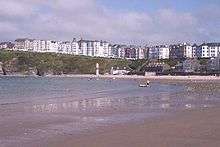
The name means either iron port or lord's port. The outer breakwater, visible at low tide only, was an abandoned project constructed in 1863 using the Port Erin Breakwater Railway and saw the first steam locomotive used on the island; a severe storm of 1884 later destroyed the breakwater and it was never rebuilt. Today, a marker buoy shows the extent of the breakwater, and the landward end is still clearly discernible. To the north-east, by the A7 road, are the earthwork remains of a motte and bailey castle known as Cronk Howe Mooar, possibly the site of a timber fortification built by Magnus Barelegs [Barefoot] c. 1100.
Transport
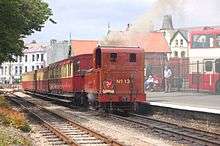
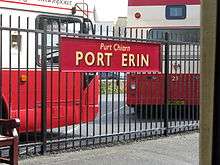
Railway
The railway station in the village forms the western terminus of the Isle of Man Railway and sits in the centre of the village. The station has been described as "the most beautiful building in town" and is constructed of distinctive red Ruabon brick in an unusual design specifically to fit into its diagonal location between the platforms and the nearby road. The station is now a fraction of its original size, with the former bay platform and sidings now occupied by the storage yard for Bus Vannin, whilst an additional area once used for maintenance has been replaced by The Haven public house. More recent developments have seen the platform shortened and a carriage shed constructed in the yard, capable of storing eight carriages. Prior to this the rolling stock was stored in the open.
Buses
Bus services operate directly through a depot in Bridson Street in the village to the island's capital Douglas via Port St Mary, Colby, Castletown and Ballasalla using route numbers 1, 2, 11 and 12; these run about every twenty minutes at weekdays and Saturdays, with a less frequent service at weekends and after 6.00pm. Some of these services (1c and 11b) use an alternative coastal route. The route is the island's busiest, partially because it calls at the island's airport. A late evening service also operates on Friday and Saturday evenings, called the Night Owl (Hullaid Oie), which charges higher fares. There are also occasional buses to Peel (Service No. 8) via Foxdale; all these buses are within the island's transport network Bus Vannin, a government-run service which replaced the railway-operated Isle Of Man Road Services in 1976, itself a subsidiary of the railway.
Other
There is a coach storage car park to the rear of the railway station, formerly occupied by Tours (Isle Of Man) Limited, though more often used by visiting coaches in recent times. A number of private taxi services operate from the village into the later hours, though other Douglas-based hackneys will serve the south on demand.
Geography
The beach is sandy and is bounded by two headlands which (on windy days) funnel the prevailing westerly wind towards the village. On sunny days, the bay acts as a suntrap. One headland, Bradda Head, has a memorial tower called Milner's Tower. The promenade, which is somewhat higher than the seafront, primarily consists of hotels - mostly built in the Victorian era, although due to changes in taste among tourists, many of these are being converted into flats and apartments. The town is famed for its views including spectacular sunsets over Port Erin Bay and Bradda Head, as well as glimpses of the Mourne Mountains in Northern Ireland in the distance.
Religion

Church Road

Droghadfayle Road
Church of England
The largest church in the village is dedicated to St Catherine and located on Church Road at its junction with the upper promenade and lies within its own grounds; in addition to regular community services the church is also well known for its summer concert series that runs on a Wednesday evening throughout the summer months from May to September, featuring local talent.
Methodist
This is located at the junction of Droghadfayle Road with the main road entering the village, and has a mid-sized, modern built community hall annexed to it which hosts the Over Sixties club regularly in addition to services. To the rear of the church lies the village's branch of the Royal British Legion in the same cluster of buildings.
Grace Baptist
Constructed in 1982 at the same time and in a similar architectural style to a surrounding housing estate, this church began life in neighbouring Castletown before relocating and expanding its current headquarters in 1985; since this time the building has also been modified and expanded subject to demand.
Catholic
Found on the outskirts of the village on the main road to Port St Mary, another modern build small church with its own parking area; it can be found at the same site as the community gospel church. It is dedicated to St Columba and was established as late as 1989 when the building was constructed in simple format.
Gospel
Located on the main approach road to the village from the Port St Mary direction, this is a further modern-build small church with a dedicated parking area to the side; it can be found at the same site as the Catholic Church and was founded in 1991 according to the growing demands for varying types of worship on the island.
Landmarks

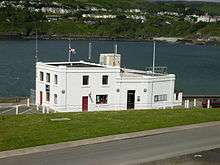
- Fish Hatchery a building in the outer harbour close to the wrecked breakwater, this was home to a University of Liverpool Marine Biology department which closed in 2006.
- Milner's Tower the distinctive keyhole-shaped building that stands on top of Bradda Head, a memorial to a local locksmith, only reachable by foot. It features on the crest and coat of arms for the village
- Railway Museum in the centre of the village and housed in the former omnibus garage of Isle of Man Road Services; open seasonally whenever the railway is in operation and accessible via the main road
- Museum Building located within the building originally constructed as a cinema but more latterly used as office space and retail accommodation
- Erin Arts Centre located in a converted church on Victoria Square the building is host to annual musical competitions and other events on a regular basis, one of several small centres for the arts on the island
- Railway Station in the centre of the village and constructed of distinctive red Ruabon brick, the station is open seasonally; winner of an Ian Allen Heritage Award in 1991
- Herdman House now a private residence but built as the village's public library and gaming room, it at one time included a billiard hall and extensive library section before conversion to its present use
- Collinson's Cafe an unusual building which is currently empty with several unique architectural features including a rotunda and large sprung dance floor from its time as a dance hall; it can be found above the promenade on the road leading to the golf course
- Lifeboat Station this can be found beyond the harbour on the road from the promenade; extended in recent years it retains its slipway and deco architectural style and is open to the public when manned.
- Police Station the Police Station closed in 2014, and is no longer manned. The closest manned Police Station in the south of the island is in Castletown. A public desk is located here.
Residents
One of the more famous residents in recent years was Formula 1 racing driver Nigel Mansell who lived on the headland to the south of the bay.
Films
The 2006 film Stormbreaker (starring Ewan McGregor) was filmed on Port Erin beach; the town has also been used by various production companies including the BBC whose serialised drama The Ginger Tree was filmed at the railway station in 1989, and the cinematic adaptation of Five Children & It. An episode of the BBC documentary marking 20 years since the end of steam trains in the U.K. The Train Now Departing filmed extensive scenes in and around the station, interviewing the station master in the process. The village has also featured in the holiday series Wish You Were Here...? and Holiday '91 with Judith Chalmers.